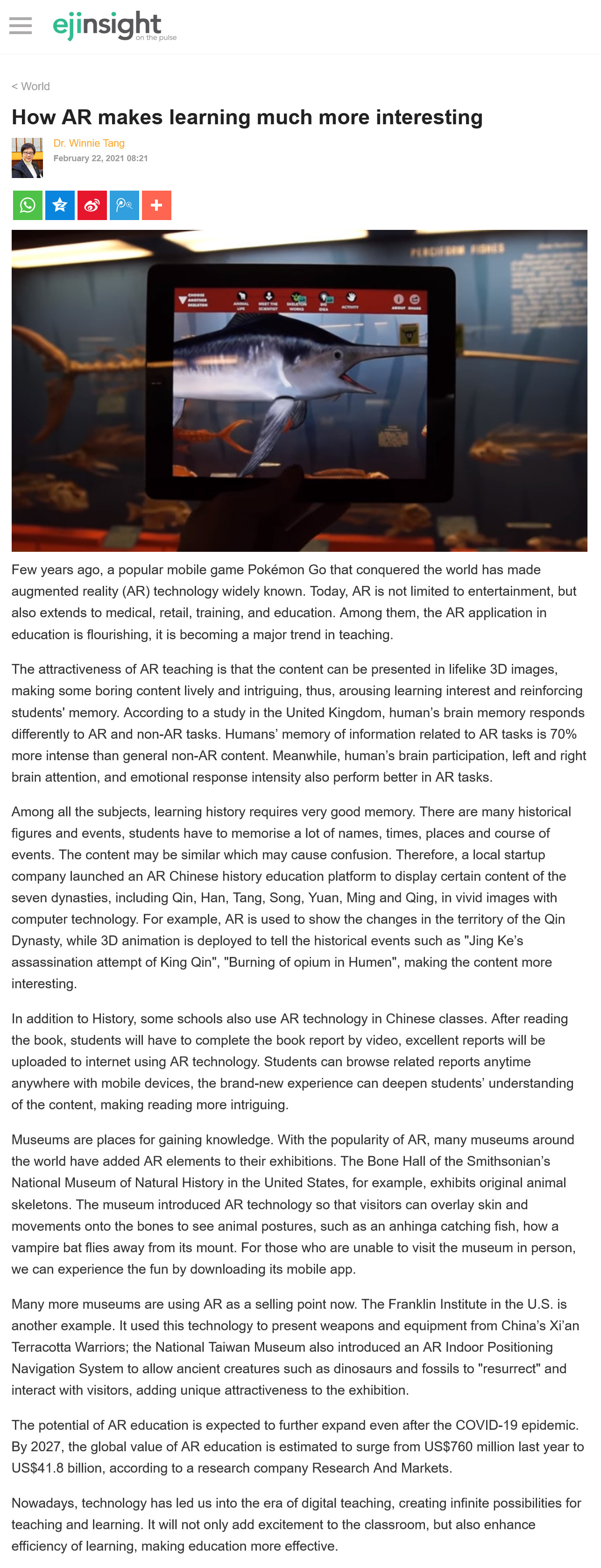網上版請按此

How AR makes learning much more interesting
Few years ago, a popular mobile game Pokémon Go that conquered the world has made augmented reality (AR) technology widely known. Today, AR is not limited to entertainment, but also extends to medical, retail, training, and education. Among them, the AR application in education is flourishing, it is becoming a major trend in teaching.
The attractiveness of AR teaching is that the content can be presented in lifelike 3D images, making some boring content lively and intriguing, thus, arousing learning interest and reinforcing students' memory. According to a study in the United Kingdom, human's brain memory responds differently to AR and non-AR tasks. Humans' memory of information related to AR tasks is 70% more intense than general non-AR content. Meanwhile, human's brain participation, left and right brain attention, and emotional response intensity also perform better in AR tasks.
Among all the subjects, learning history requires very good memory. There are many historical figures and events, students have to memorise a lot of names, times, places and course of events. The content may be similar which may cause confusion. Therefore, a local startup company launched an AR Chinese history education platform to display certain content of the seven dynasties, including Qin, Han, Tang, Song, Yuan, Ming and Qing, in vivid images with computer technology. For example, AR is used to show the changes in the territory of the Qin Dynasty, while 3D animation is deployed to tell the historical events such as "Jing Ke's assassination attempt of King Qin", "Burning of opium in Humen", making the content more interesting.
In addition to History, some schools also use AR technology in Chinese classes. After reading the book, students will have to complete the book report by video, excellent reports will be uploaded to internet using AR technology. Students can browse related reports anytime anywhere with mobile devices, the brand-new experience can deepen students' understanding of the content, making reading more intriguing.
Museums are places for gaining knowledge. With the popularity of AR, many museums around the world have added AR elements to their exhibitions. The Bone Hall of the Smithsonian's National Museum of Natural History in the United States, for example, exhibits original animal skeletons. The museum introduced AR technology so that visitors can overlay skin and movements onto the bones to see animal postures, such as an anhinga catching fish, how a vampire bat flies away from its mount. For those who are unable to visit the museum in person, we can experience the fun by downloading its mobile app.
Many more museums are using AR as a selling point now. The Franklin Institute in the U.S. is another example. It used this technology to present weapons and equipment from China's Xi'an Terracotta Warriors; the National Taiwan Museum also introduced an AR Indoor Positioning Navigation System to allow ancient creatures such as dinosaurs and fossils to "resurrect" and interact with visitors, adding unique attractiveness to the exhibition.
The potential of AR education is expected to further expand even after the COVID-19 epidemic. By 2027, the global value of AR education is estimated to surge from US$760 million last year to US$41.8 billion, according to a research company Research And Markets.
Nowadays, technology has led us into the era of digital teaching, creating infinite possibilities for teaching and learning. It will not only add excitement to the classroom, but also enhance efficiency of learning, making education more effective.
Dr. Winnie Tang
Adjunct Professor, Department of Computer Science, Faculty of Engineering; Department of Geography, Faculty of Social Sciences; and Faculty of Architecture, The University of Hong Kong